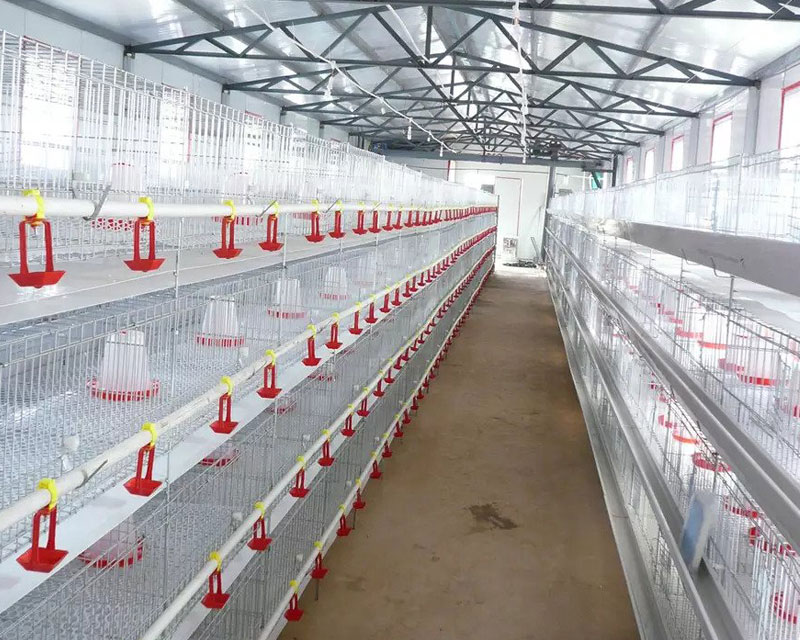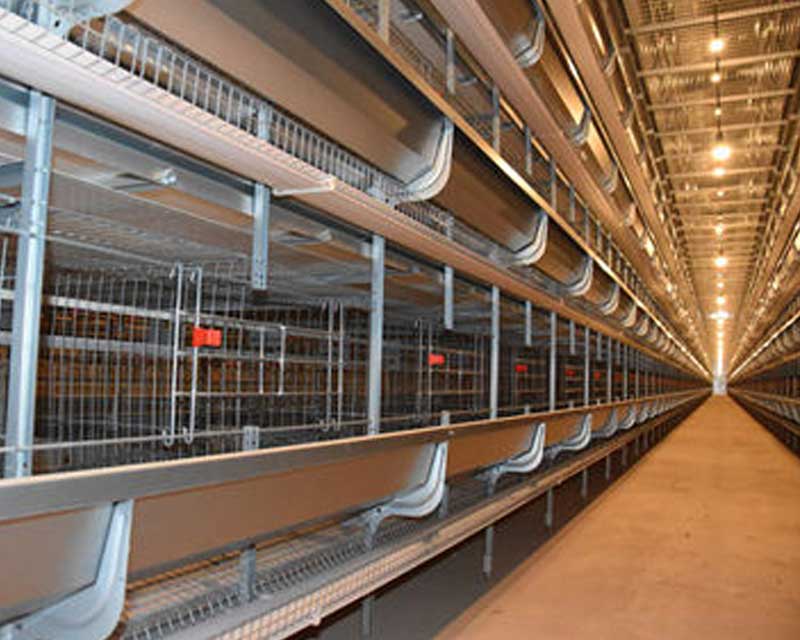What are the basic requirements for a poultry house?
Larger-scale commercial production as a more intensive chicken raising is different from backyard chicken raising. Therefore, to create a good environment for chickens, it is necessary to reasonably design and build a chicken house that is conducive to the growth of chickens. Chickens have no sweat glands and mainly rely on breathing to dissipate heat, its heat resistance is worse than its cold resistance. It likes a warm, cool, dry, fresh air, and quiet environment. For this reason, the chicken house should be built on higher terrain, with good ventilation, sufficient water, power, and convenient transportation. Dry noise, no pollution, easy to disinfect and isolate the place.

The space of the chicken house
The area and capacity of the chicken house depend on the degree of mechanization and the management level of the breeders. The chicken house built by the farmer can be determined according to the specific conditions of the site. The span of the open chicken house should not be too large, otherwise, it will be unfavorable for the ventilation and lighting of the chicken house. The span of the chicken house is generally 6-9m. The span of the chicken house with mechanical ventilation can reach 9-12m. The length of the chicken house can be adjusted according to local conditions. Small-scale chicken houses raising 2800-5000 laying hens in chicken cages can be designed to be 7-8m wide and 33-53m long. Large and medium-sized chicken houses keeping 5000-10000 layers can be designed to be 10-12m wide, and 40-65m long.
The height of the chicken house
The height of the chicken house should be determined according to the feeding method, manure removal method, span, and climatic conditions. Generally, the distance between the top layer of the chicken cage and the roof is 1.5m.
The wall
The wall of the chicken house has good thermal insulation, a simple structure, is easy to clean and disinfect, strong and anti-vibration. In cold climate areas, the wall should be appropriately thickened. In mild climate areas, the walls may be slightly thinner. The outside of the wall is plastered with cement, and the interior wall is covered with cement or white lime.
The floor
The floor of the chicken house should be waterproof, solid, smooth but not slippery, corrosion-resistant, have a certain thermal insulation performance, moisture-proof, have no water accumulation, and be easy to clean and disinfect. Generally, it should be 20-30cm above the ground in the field to create a high and dry environment. To facilitate drainage and avoid the accumulation of sewage, the ground in the house should have a slope of 2%--3% towards the direction of the drainage ditch.
Doors and windows
Doors, windows, and vent doors are generally located on the south side of the south-facing chicken house. The size of the door should consider so that all facilities and working vehicles can enter and exit smoothly. Generally, a single door is 2m high and 1m wide, two doors are 2m high and 1.6m wide. The windows of the chicken house should consider the lighting and ventilation. It can be set on the front and rear walls, and the front window should be wide. It can be lower from the ground to facilitate lighting. The rear window should be small, about 2/3 of the front window, and can be slightly higher from the ground to facilitate ventilation in summer. Under the premise of basically satisfying the light and ventilation in summer, the number of windows should be as small as possible for chicken houses in cold areas. Although the closed chicken house does not need windows to provide light and ventilation, some emergency windows should also be set to prevent the urgent need in the event of power outages and other accidents.
The roof
The roof of the chicken house should be insulated, waterproof, firm, and light in weight. The main forms of the roof of the chicken house are flat-top, single-slope, double-slope, bell tower, half bell tower, and vault. The chicken house should be equipped with a ceiling as much as possible so that a roof room is formed between the roof and the ceiling to enhance the heat insulation capacity of the chicken house.
Other basic requirements of chicken house structure
Foundation and ground: the ground of the chicken house should be 20-30 cm higher than the outside, and the foundation should be deep and strong. In areas with high groundwater levels and relatively humid areas, the foundation should be raised or a moisture-proof layer should be laid under the ground. In addition to being easy to rinse and disinfect, it can also prevent rodents.
Chicken house structure: It is best to use brick and wood structures or materials with a good thermal insulation effect. If the roof is asbestos tile, it is required to open a ventilation building at the ridge every 12 meters, and the roof is a three-layer structure: the outermost layer is asbestos tile, and the middle layer is straw, and the innermost layer is waterproof linoleum paper or color-striped cloth. The bearing capacity of the foundation, beams, columns, and roofs must meet the maximum wind, flood, and snow protection requirements of the area.
Building size: It is designed according to the batch breeding volume of each chicken house is 5000 chickens. The height from the eaves to the ground is 2.6±0.1 meters, the length of the chicken house should not exceed 60 meters, and the span should not exceed 9 meters.
Drainage ditch: Set up a drainage ditch (40 cm wide and 10 cm deep) 30-50 cm away from the corner of the chicken house. If the chicken house is built on a slope, a drainage channel should be opened uphill.
Disinfection pool: At least one-foot disinfection pool/basin and one disinfection hand basin are arranged in front of each chicken house (the fixed foot disinfection pool is made of cement, and the specifications are about 50cm long, 30cm wide and 5cm deep).
Sports field: It is required to have good greening, no stagnant water, and no weeds.

 4 Tier H Type Broiler Cage Project In South Africa
4 Tier H Type Broiler Cage Project In South Africa Layer Cage Project In Cuba
Layer Cage Project In Cuba H Type Layer Cage Project In Southeast Asia
H Type Layer Cage Project In Southeast Asia A Type Layer Cage Installed In West Africa
A Type Layer Cage Installed In West Africa Nigeria H Type Layer Cage Project
Nigeria H Type Layer Cage Project H Type Layer Cage Installed In Togo
H Type Layer Cage Installed In Togo